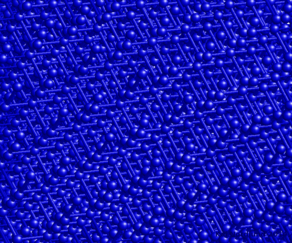In condensed-matter physics, channelling (or channeling) is the process that constrains the path of a charged particle in a crystalline solid.[1][2][3]
Many physical phenomena can occur when a charged particle is incident upon a solid target, e.g., elastic scattering, inelastic energy-loss processes, secondary-electron emission, electromagnetic radiation, nuclear reactions, etc. All of these processes have cross sections which depend on the impact parameters involved in collisions with individual target atoms. When the target material is homogeneous and isotropic, the impact-parameter distribution is independent of the orientation of the momentum of the particle and interaction processes are also orientation-independent. When the target material is monocrystalline, the yields of physical processes are very strongly dependent on the orientation of the momentum of the particle relative to the crystalline axes or planes. Or in other words, the stopping power of the particle is much lower in certain directions than others. This effect is commonly called the "channelling" effect. It is related to other orientation-dependent effects, such as particle diffraction. These relationships will be discussed in detail later.
- ^ Robinson, Mark T.; Oen, O. S. (1963). "The Channeling of Energetic Atoms in Crystal Lattices". Applied Physics Letters. 2 (2): 30. Bibcode:1963ApPhL...2...30R. doi:10.1063/1.1753757.
- ^ Gemmell, D. S. (1974). "Channeling and related effects in the motion of charged particles through crystals". Rev. Mod. Phys. 46 (1): 129. Bibcode:1974RvMP...46..129G. doi:10.1103/RevModPhys.46.129.
- ^ Robinson, Mark T.; Oen, Ordean S. (1963-12-15). "Computer Studies of the Slowing Down of Energetic Atoms in Crystals". Physical Review. 132 (6): 2385–2398. doi:10.1103/PhysRev.132.2385.

